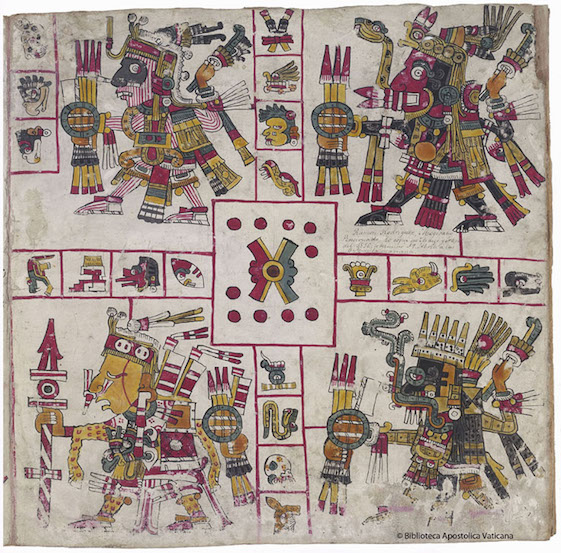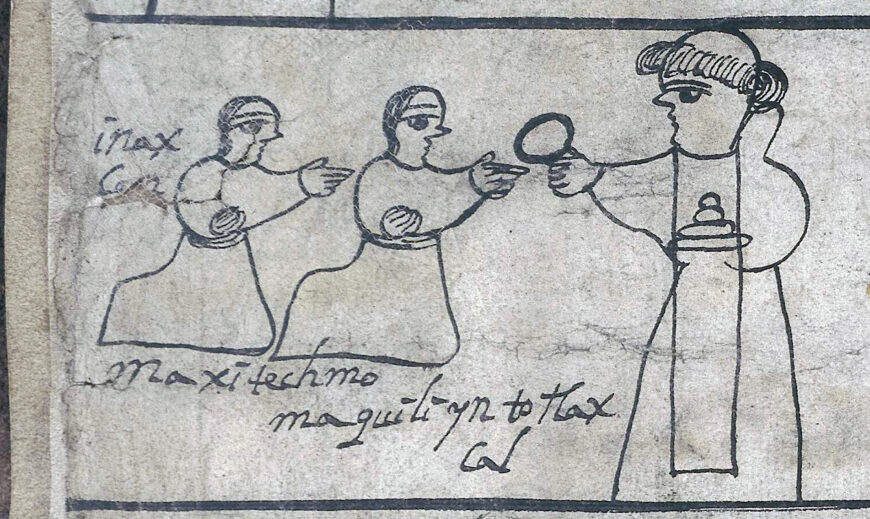
Eucharist (detail), Egerton Codex, Lord’s Prayer in Testerian script with Nahuatl translation, 22.7 x 34.4 cm (© The Trustees of the British Museum, London)
The conquest and colonization of the continents we now call the Americas was a time of immense upheaval and violence as two distant cultures, previously unaware of the others’ existence, came into contact for the first time. Despite coming from different cultural, ethnic, and linguistic backgrounds, somehow Europeans and Indigenous peoples managed to communicate through gestures, objects, and spoken language.
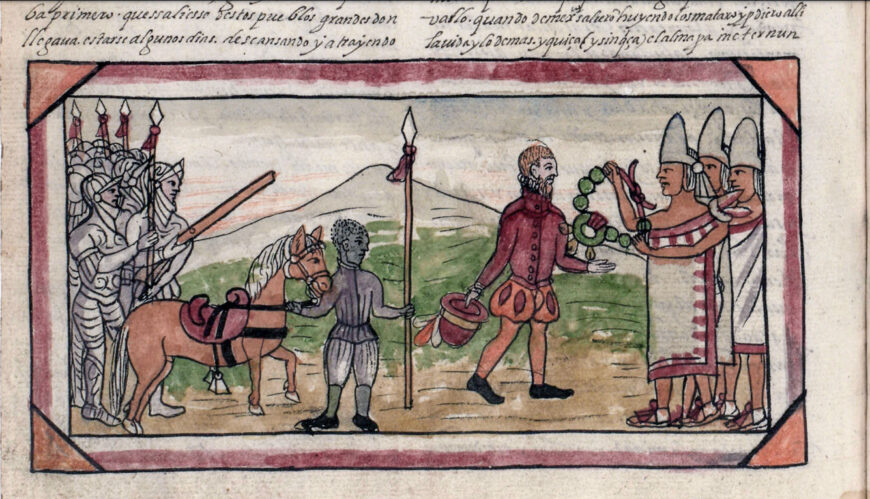
Encounter of Cortés and Moctezuma (detail), Diego Durán, Historia de las Indias de Nueva España e islas de la tierra firme (manuscript), 1579, 28 x 19 cm, p. 214 (Biblioteca Nacional de España, Madrid)
Cortés and Moctezuma
The encounter in 1521 of the Spanish conquistador Hernán Cortés and the Mexica (Aztec) emperor Moctezuma II is one of the earliest such exchanges in Mexico. It is illustrated in a 1581 manuscript compiled by Dominican friar Diego Durán entitled, The History of the Indies of New Spain. The image, which was created by an unnamed Indigenous artist-scribe who was not witness to the event, features Moctezuma flanked by two courtiers. The Mexica tlatoani, Moctezuma II, hands what looks like a large beaded necklace to Cortés, who has dismounted his horse, the reins of which are held by an African attendant. The conquistador holds his hat behind him in a gesture of respect to the Mexica ruler.
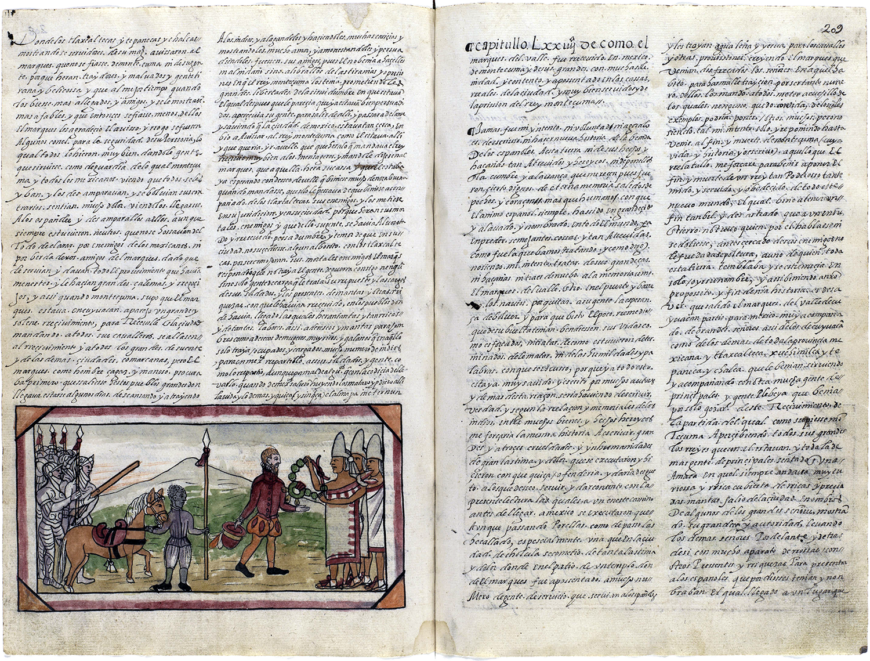
Diego Durán, Historia de las Indias de Nueva España e islas de la tierra firme (manuscript), 1579, 28 x 19 cm, p. 214 (Biblioteca Nacional de España, Madrid)
This is a moment of exchange between the two leaders, a cross-cultural exchange wherein they recognize each others’ elite status. The necklace, likely made of green stone, is just one example of the types of objects that were used to communicate across linguistic and cultural boundaries. Objects and images continued to play an important role in the early contact period, and soon new types of objects, such as the Testerian catechisms, were created to aid in communication.
A hybrid script
The Testerian catechisms are visual teaching tools that were used by missionaries to aid in converting the Indigenous population of Central Mexico to Christianity. These manuscripts were named after a Franciscan named Jacopo de Testera who reportedly, upon arriving in Mexico in 1529, faced difficulties learning Nahuatl. In response, he developed a drawing style, referred to as the Testerian “script,” to communicate Christian doctrine visually. This featured simplified figures, usually rendered in profile and outlined in black against flat backgrounds. Alongside each section of figures, the corresponding message is translated into Nahuatl, written in Latin letters. Used for the recitation of Catholic doctrine, the Testerian “script” used symbols and simplified figures as a mnemonic system, meaning that they were memory aids for reciting doctrine rather than a formalized writing system. The manuscripts might remind one today of comic books in their organization of scenes into horizontal registers. The idea was to create visual aids that would transcend language barriers, creating visually legible translations of Christian beliefs as part of the Franciscan evangelical agenda.
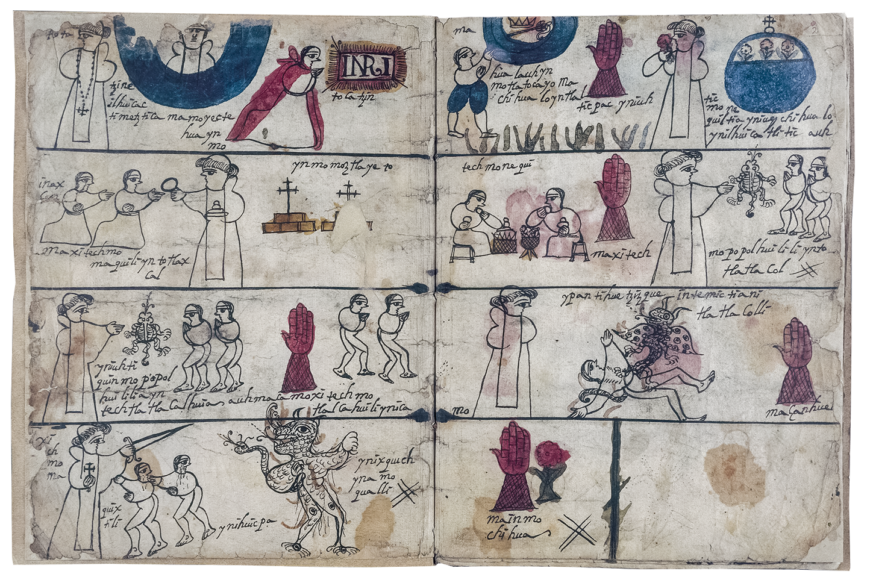
Egerton Codex, Lord’s Prayer in Testerian script with Nahuatl translation, 22.7 x 34.4 cm (© The Trustees of the British Museum, London)
One particularly elaborate example is a manuscript called Egerton 2898, now housed in the British Museum and signed by Dom Locas Matheo Escriuano. Like other Testerian catechism manuscripts, the Egerton manuscript’s visual translation of Christian doctrine echos the style of the ancient Mesoamerican writing system seen in manuscripts like the Codex Borgia, an Mexica manuscript made before the Spanish conquest.
Reading the manuscript
The Egerton 2898, like the Codex Borgia, features figures outlined in black sometimes filled in with flat areas of color. The figures are organized into clearly delineated registers (horizontal bands). Stylistic similarities to the Codex Borgia are purposeful, as the artists aimed to create manuscripts that were recognizable for Indigenous audiences. Not only does the Egerton codex render the Lord’s Prayer (a central Christian prayer) in a Mesoamerican-influenced hieroglyphic style, the actual translation of the prayer is altered and augmented for an Indigenous audience.
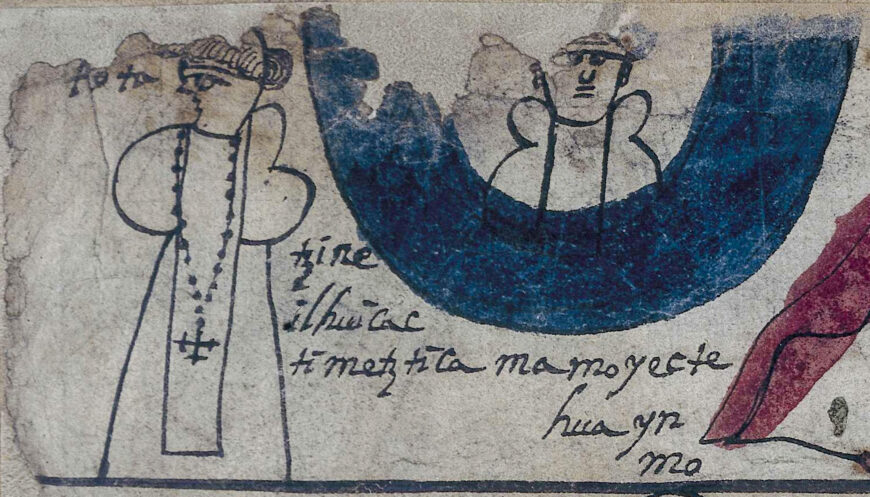
Our Father, who art in heaven (detail), Egerton Codex, Lord’s Prayer in Testerian script with Nahuatl translation, 22.7 x 34.4 cm (© The Trustees of the British Museum, London)
Read from left to right across both pages, the first group of figures shows a friar wearing a cross pendant and a winged figure in an elevated half circle, representing “Our Father who Art in Heaven.” The prayer goes on from there and is interspersed with large upright hands in red (see image of entire page above), which scholars believe comes from Nahuatl, the Mexica language. In Nahuatl the word for hand begins with the same sounds as the imperative clause, “ma,” therefore the hand sign is used at the start of the compulsory clauses of the prayer. [1]
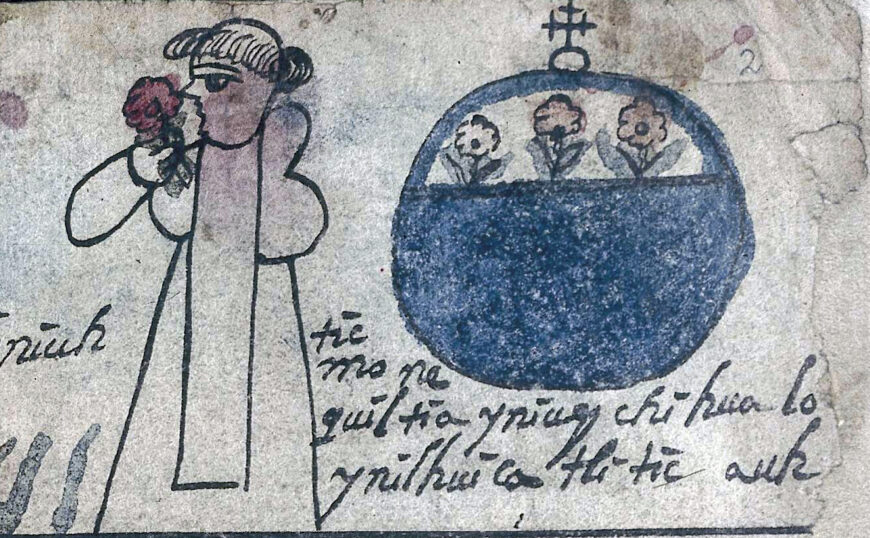
Friar smells a flower (detail), Egerton Codex, Lord’s Prayer in Testerian script with Nahuatl translation, 22.7 x 34.4 cm (© The Trustees of the British Museum, London)
There is also an addition to the prayer. In the upper right hand corner a friar smells a flower alongside a flower-filled circle with a cross on top. This has been interpreted to represent an additional clause of the prayer, “on earth the Father smells the flower; let flowers multiply in the Christian universe.” Flowers were sacred in Mesoamerican world view. The Mexica associated them with the gods, poetry, and music. The addition of this flowery reference within the iconic Christian prayer shows the ways that the conversion efforts were not mono directional. Aspects of Indigenous culture and religion were combined with Christian ideas in order to more successfully bridge the cultural divides.
![Diego Valadés, “The Ideal Atrium,” 1579, copperplate engraving, in Rhetorica Christiana ad concionandi et orandi usum accommodate […] ex Indorum maximè deprompta sunt historiis (Getty Research Institute, Los Angeles)](https://smarthistory.org/wp-content/uploads/2019/11/RC-atrium-copy-2.jpg)
Diego Valadés, “Allegorical Atrium,” 1579, copperplate engraving, in Rhetorica Christiana ad concionandi et orandi usum accommodate […] ex Indorum maximè deprompta sunt historiis (Getty Research Institute, Los Angeles)
Teaching Christian doctrine
We get a sense of how the friars used the Testerian catechisms, or at least other, similar images, in an image within a book called the Rhetorica Cristiana. Written by a Franciscan mestizo named Diego Valadés, it served as a sort of guide-book for Christian missionary work in the Americas. At the top left corner of the page called the “Allegorical Atrium,” a friar instructs a group of Indigenous students in Christian doctrine. The friar, a leader of the Franciscan order named Pedro de Gante, holds the 16th century version of the laser pointer—a long stick that he uses to point at a symbol inscribed within a larger, hanging manuscript. Whether this is a Testerian style catechism, or some other type of visual teaching aid, is not immediately clear. But the message is clear: the friars placed high value on images as tools of communication. The accompanying Latin inscription reads: “Fray Pedro de Gante explains everything.”
The “explaining,” of course, was an act of conversion of which Indigenous peoples did not have a choice. The colonial period was one of power differentials, and also of a push and pull whereby the new society being created did not replicate either of the original two, but ultimately formed something new. The Testerian catechisms are fascinating documents for the ways that they visually display encounter and burgeoning transformation into a new, multiethnic society.

